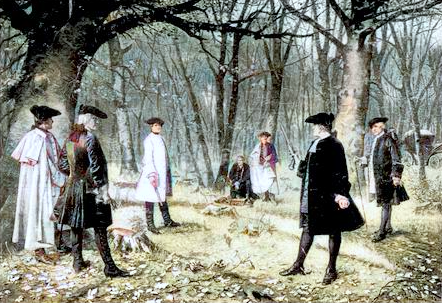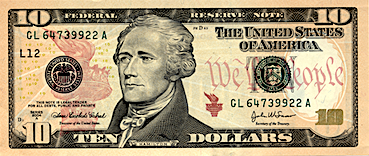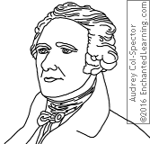Introduction
Alexander Hamilton (born 1755 or 1757, died 1804) was perhaps the original American self-made man, an immigrant who rose from poverty to help establish the foundations of the United States. This Founding Father fought in the American Revolutionary War, was a leading voice in the Constitutional Convention, co-wrote the Federalist Papers with James Madison and John Jay, and established a strong national banking system as the first US Secretary of the Treasury. Hamilton’s life was cut short in a duel with Aaron Burr, a former friend.
Early Life
Hamilton was born to an impoverished life in the British West Indies. With money tight, Hamilton began working at 11 as a clerk. He made such an impression that in 1772 his boss and locals raised funds for Hamilton to travel to New York and attend King’s College (now Columbia University). But before he could finish his degree he got swept up with the American colonies’ stirrings of rebellion. Embracing the blossoming revolution, he made his first foray into political writings in 1774 by writing against Britain’s taxation policies and regularly giving speeches at public meetings.
The Revolutionary War
When the American Revolutionary War started in 1775, Hamilton joined the New York Provincial Artillery Company. While fighting in the army he met and impressed General George Washington, who remained his mentor long after the war. Hamilton’s true talent lay not in fighting—as Washington’s aide, he churned out mounds of persuasive writing. During this period, he married Elizabeth Schuyler.
Hamilton returned to fighting as an officer in the Battle of Yorktown; this battle led to the defeat of Britain and the establishment of the United States of America.
Law and Politics
Following peace with Britain in 1783, Hamilton had a career as a distinguished lawyer in New York. He intertwined law with politics; he was always readily available either to take on a legal case or to advise a President. The latter made him as many foes as friends.
Hamilton was notorious for his controversial and divisive opinions. Central to this was his conviction that America needed a powerful central government to succeed in unifying the states. But this point of view was so contentious that it led to a political split into two parties: the Federalists (championed by Hamilton) and the Democratic-Republicans (led by Thomas Jefferson).
Crucial to all of this was Hamilton’s view that the original Articles of Confederation were heavily flawed and that a proper Constitution for the new nation was desperately needed.
Although today the US Constitution is viewed as unassailable, it is easy to overlook how popular the opposition to its ratification was. In support of the Constitution, Hamilton, with James Madison and John Jay, wrote and published a series of essays called The Federalist Papers (originally entitled The Federalist), written under the pseudonym Publius. These supported the view that a strong national government was necessary, and that this could be achieved through the proposed Constitution. They ended up writing 85 essays, to be distributed to the politicians and the public. Hamilton wrote a stunning 51 of these!
The Constitution was ratified in 1788, creating the United States as we know it. In 1789, Hamilton was appointed as President Washington’s Secretary of the Treasury. He was as close to Washington as ever, and many felt that Hamilton had an unfair hold on the President’s ear.
Hamilton consistently supported a stronger central government, especially in matters of economics. His vehement opponents, including Thomas Jefferson, wanted to maintain the strength of each of the 13 individual states within the Union and not allow the national government to swell in size and power, taking command of the nation’s finances. Hamilton’s opposition only agreed to his proposed economic policies when, in 1790, they made a deal that, in exchange for their support, Hamilton would in turn support moving the nation’s capital near the Potomac, making possible what is now Washington, DC.
The Duel

The duel (derived from a painting by J. Mund).
Alexander Hamilton lost his life in 1804, in a duel with Vice President Aaron Burr.
Burr blamed Hamilton for Burr’s failure to win the Presidency in 1800, as well as for his loss in the 1804 race for governor of New York. But the animosity between the two had begun long before that.
So Burr challenged Hamilton to a duel. Duelling had begun to be outlawed, and at that point the practice was illegal in both New York and New Jersey. But, as the law was more heavily enforced in the former, they went down to Weehawken, New Jersey, to duel. After a count, both men fired their guns. Burr’s shot hit Hamilton. Hamilton’s missed—it is unknown if it was a bad shot, or if he was making a point of shooting into the air and away from Burr.
Whatever the case, Hamilton succumbed to his wound, and he died on July 12, 1804, the following day.
Burr was charged with murder, but found not guilty, in both New York and New Jersey. Nevertheless, his political career was destroyed, and he lived in Europe for most of the rest of his life.
Legacy

Hamilton’s portrait is on the $10 bill today.
An often overlooked Founding Father, Alexander Hamilton left a mixed but enduring legacy. From the founding of the Federalist party and the support he gave to the Constitution’s ratification, to his structuring of American banking and taxation, he fundamentally shaped the political and economic systems of the United States.

